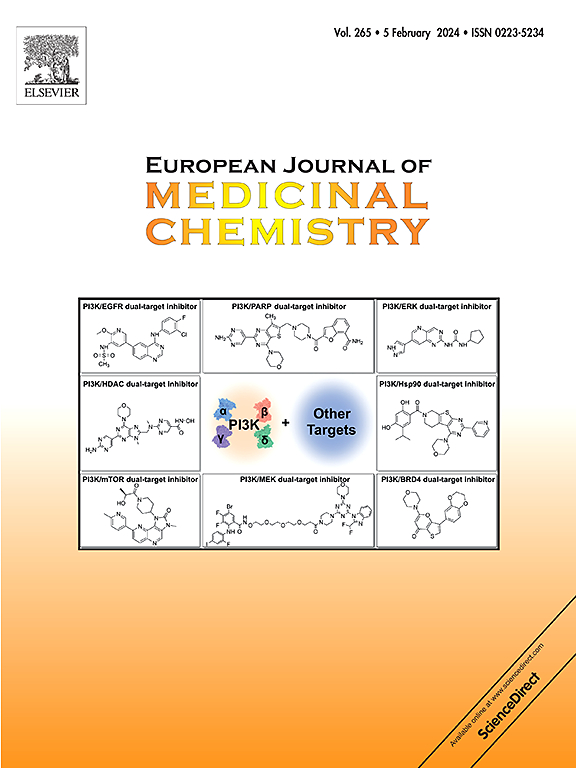Novel sodium–hydrogen exchanger 1 inhibitors with diphenyl ketone scaffold: Design, Synthesis, mechanism and evaluation in mice model of heart failure
IF 6
2区 医学
Q1 CHEMISTRY, MEDICINAL
引用次数: 0
Abstract
Sodium-hydrogen exchanger 1 (NHE1) is a potential target for drug discovery of heart failure (HF). Cardioprotection effect of empagliflozin (EMPA) was reported to be related to binding with NHE1 protein. Herein, a series of NHE1 inhibitors bearing benzhydryl and diphenyl ketone skeleton were rationally designed and efficiently synthesized. Cell viability assay and pH recovery experiment based on H9c2 cells were conducted and compound 7g was found to have equal NHE1 inhibitory activity to cariporide (0.64 μM) with the IC50 values of 0.78 μM. In vitro, 7g at 1 μM effectively rescued glucose deprivation (GD)-induced cellular damage by decreased overload of Ca2+ concentration and reactive oxygen species (ROS), improved mitochondrial dysfunction and autophagy. In vivo, compared with the clinically approved drug empagliflozin (30 mg/kg), 7g alleviated left ventricular systolic dysfunction in a heart failure model induced by isoproterenol (ISO) at lower concentration (10 mg/kg). In summary, this study supplies a promising lead compound with novel scaffold for NHE1 inhibitor and also provide a feasible strategy for HF drug discovery.


具有二苯酮支架的新型钠-氢交换机 1 抑制剂:设计、合成、机理以及在心力衰竭小鼠模型中的评估
钠氢交换剂1 (NHE1)是心力衰竭(HF)药物开发的潜在靶点。据报道,恩格列净(EMPA)的心脏保护作用与NHE1蛋白的结合有关。本文合理设计并合成了一系列以苯并羟基和二苯酮为骨架的NHE1抑制剂。以H9c2细胞为基础进行细胞活力测定和pH恢复实验,发现化合物7g与cariporide (0.64 μM)具有相同的NHE1抑制活性,IC50值为0.78 μM。在体外,7g在1 μM下,通过降低Ca2+浓度过载和活性氧(ROS),改善线粒体功能障碍和自噬,有效地挽救了葡萄糖剥夺(GD)诱导的细胞损伤。在体内,与临床批准的药物依格列净(30 mg/kg)相比,7g可减轻低浓度(10 mg/kg)异丙肾上腺素(ISO)诱导的心力衰竭模型左室收缩功能障碍。综上所述,本研究为NHE1抑制剂提供了一种有前景的新型支架先导化合物,也为HF药物的开发提供了一种可行的策略。
本文章由计算机程序翻译,如有差异,请以英文原文为准。
求助全文
约1分钟内获得全文
求助全文
来源期刊
CiteScore
11.70
自引率
9.00%
发文量
863
审稿时长
29 days
期刊介绍:
The European Journal of Medicinal Chemistry is a global journal that publishes studies on all aspects of medicinal chemistry. It provides a medium for publication of original papers and also welcomes critical review papers.
A typical paper would report on the organic synthesis, characterization and pharmacological evaluation of compounds. Other topics of interest are drug design, QSAR, molecular modeling, drug-receptor interactions, molecular aspects of drug metabolism, prodrug synthesis and drug targeting. The journal expects manuscripts to present the rational for a study, provide insight into the design of compounds or understanding of mechanism, or clarify the targets.

 求助内容:
求助内容: 应助结果提醒方式:
应助结果提醒方式:


